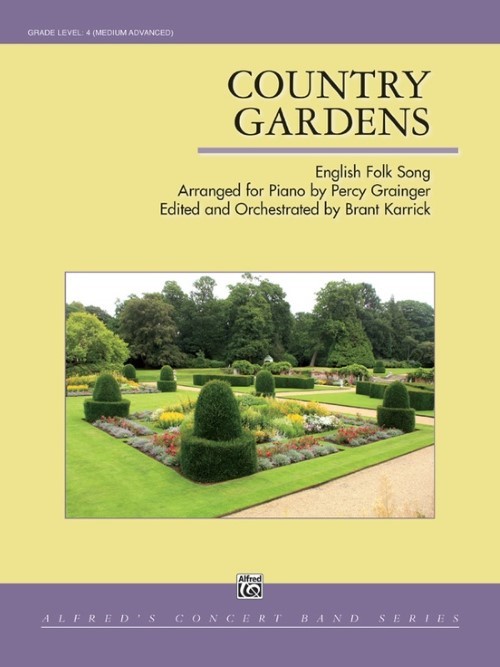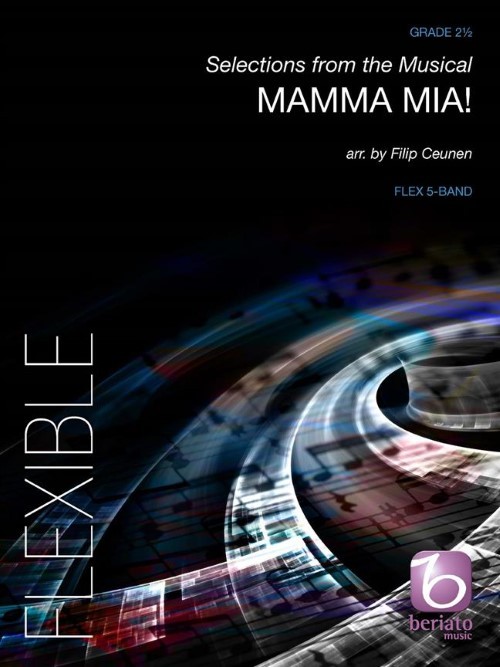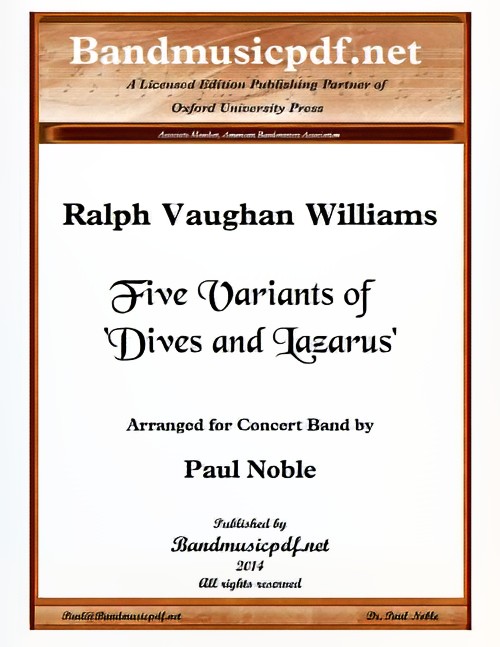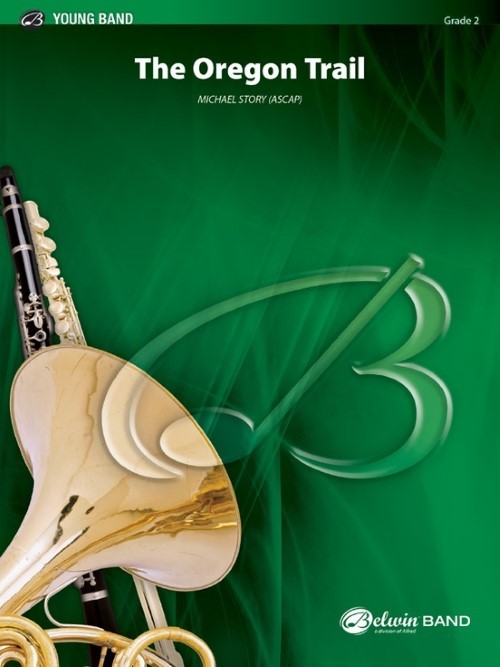Results
-
 £176.50
£176.50Four Norfolk Dances - Philip Sparke
Norfolk is one of the most beautiful counties in England, famous for its charming villages and boundless broads, a popular centre for sailing holidays. It is also the home of one of the best known of all British composers, Sir Malcolm Arnold. The date of the premiere of this piece was to fall close to his 80th birthday, so Philip Sparke decided to write something of a birthday tribute. Some of Arnold's best-loved orchestral works are his sets of dances: there are two sets of English Dances, Four Scottish Dances, Four Cornish Dances etc., most of which have been arranged for concert band at one time or another. Philip Sparke thought it would be appropriate for the concert band tohave its own set of dances and wrote Four Norfolk Dances very much in the style of Arnold's suites.
Estimated dispatch 7-14 working days
-
 £72.99
£72.99Crystal Waves - Stef Minnebo
During the first half of the sixties the world was under the spell of Californian surf music. Groups such as the Beach Boys, Dick Dale and his Del- Tones, The Surfaris and The Challengers dominated the international charts. The summery and happy style was very catchy, and as it turned out had a great influence on early rock music. Crystal Waves is an ode to this surf music and utilises its characteristic melodies, chords and rhythms to form a catchy piece for concert band.
Estimated dispatch 7-14 working days
-
 £121.00
£121.00In Memoriam - Johan Halvorsen
Johan Halvorsens In Memoriam, Opus 30 was written for the great Norwegian poet Bjornstjerne Bjornson. The two men became very close friends and Halvorsen composed a funeral march in Bjornsons honor upon his death in 1910. The musics link with Bjornson is underscored by the fact that it opens with a paraphrase of the Norwegian national anthem. At the peak, it suddenly falls away, and following a roll of the timpani, the anthem is played in its entirety. Vocal parts sung by members of the ensemble contribute to the overall effect and make this a most memorable and moving work.
Estimated dispatch 7-14 working days
-
 £78.00
£78.00Country Gardens (Concert Band - Score and Parts) - Grainger, Percy Aldridge - Karrick, Brant
Grainger's first piano arrangement of this English morris dance tune was completed in 1918 as a birthday gift for his mother. It became extremely popular and was his greatest commercial and financial success. Even this simple tune displays his genius with harmony, counterpoint, and colour. This very playable arrangement is an excellent way to introduce your students to the music of Percy Grainger.Duration: 2:10
Estimated dispatch 7-14 working days
-
 £82.50
£82.50Power Play - Robert E. Foster Jr.
Power Play was commissioned by band director Robert Ball and the Mill Creek Middle School Band, Shawnee, Kansas. This exciting addition to young band repertoire was written to deliver an energetic element to concert programs. Pushing the tempo will help players develop their technique and, along with exaggerating the accents, will contribute to the driving force of the piece. While the overall effect sounds difficult, it is very playable by middle or high school bands and will be a reliable power source for your next performance.
Estimated dispatch 7-14 working days
-
 £84.99
£84.99Mamma Mia!, Selections from (Flexible Ensemble - Score and Parts) - Ceunen, Filip
Some bands and their music are everlasting. A good example of such a group can be found in ABBA! The fact that a popular musical was based on ABBA songs is the best proof you can get. Even today, both young and old sing along to the international hits of this Swedish group! Filip Ceunen took the very best songs and created an excellent and playable medley scored for flexible ensemble. Be prepared for an audience singing or humming along with such classic songs as 'Mamma Mia', 'Dancing Queen', 'Fernando', 'The Winner Takes It All', and of course 'Money, Money, Money'.Duration: 5.00
Estimated dispatch 7-14 working days
-
 £225.00
£225.00Five Variants of Dives and Lazarus (Concert Band - Score and Parts) - Williams, Vaughan - Noble, Paul
Five Variants of Dives and Lazarus is a Concert Band arrangement from the original work for string orchestra and harp by Ralph Vaughan Williams. The composition is based on the folk tune Dives and Lazarus, one of the folk songs quoted in Vaughan Williams' English Folk Song Suite. The ancient theme on which these variations are based goes back to the sixteenth century, and is known by various titles. Dives and Lazarus is a story told by Jesus in the Gospel of Luke. It tells of an unnamed rich man and a poor beggar named Lazarus. In the Latin Bible, the unnamed rich man is referred to as Dives from dives, the Latin word for rich. This work, based on the tune that Vaughan Williams had loved all his life, which came from the very soil of England, ageless and anonymous, was played at the composer's funeral service in Westminster Abbey on 19th September 1958.
Estimated dispatch 7-14 working days
-
 £76.99
£76.99Ayers Rock (Concert Band - Score and Parts) - Hogestein, Henk
The famous monolith Uluru (formally known as Ayers Rock) is the one of the attractions in the Northern Territory of Australia. This colossal red rock lies in the middle of a desert plain. At dusk, a beautiful spectacle develops as the setting sun envelops the rock in rose-red hues. There are tourists who used to climb the rock, while this is a taboo according to the indigenous religion of the Aboriginals. Besides, the climb is very strenuous. A walk around the rock is also an unforgettable experience. During a journey through Australia, Henk Hogestein was inspired by this rock; he composed this robust rock number to cherish the memory of it.Duration: 3:00
Estimated dispatch 7-14 working days
-
 £60.50
£60.50The Oregon Trail (Concert Band - Score and Parts) - Story, Michael
The history of America was written by the pioneers who braved all the elements and hardships they faced on a daily basis. In a salute to those men and women who began their trek near Independence, Missouri, and ended it at the Columbia River region of Oregon, Michael Story brings us a sound portrait of this very important pathway. With bold sonic strokes from the winds and percussion, the work moves with energy and drive. This is an important contribution to the concert and contest literature for the young concert band.Duration: 4.45
Estimated dispatch 7-14 working days
-
 £76.99
£76.99Introduction & Punk Wind Band Set (Score & Parts)
Torstein Aagaard-Nilsen's (1964) way of composing can be described as: uncompromising, wilful and contemporary. It is not surprising, therefore, that this occasionally causes a stir. In the middle of the Seventies a trend arose in youth culture, which was characterized by provocation, distrust of the great ideologies, and the autonomy of the individual. Punk is playful, aggressive, often humorous, and anti-everything, which inevitably leads to self-irony. The first part of Aagaard-Nielsen's composition (Introduction) is a texture based mainly on one short theme. This pompous theme breathes a spirit of cold empty plains, where icy winds sigh around your head. In the vehement Punk (Presto barbaro!) there is no longer any question of a theme. The basis for this part is formed by a repetitive motif (a descending minor third). This motif is alternated with very powerful percussion beats and later on shrill harmonies. 04:30
Estimated dispatch 7-14 working days
